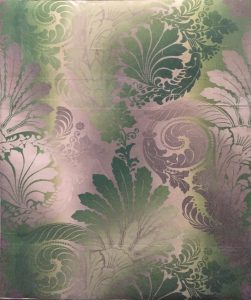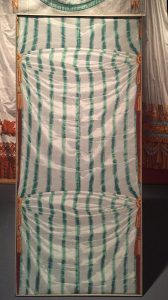This review of a recent wallpaper exhibition was written for the Wallpaper History Society.
Review: ‘Faire Le Mur – Quatre Siêcles de Papiers Peints’ at La Musée des Arts Décoratifs, Paris, France.
January 21st to June 12th, 2016.
The punning title of this exhibition puzzled me; faire le mur means to sneak out or go over the wall. But if its subtitle – 4 centuries of wallpaper – promised an (exagurated – actually 350) international narrative of papiers peints, this proved misleading. The 300 wallpapers selected for display from the museum’s 400,000 reserve collection were virtually all French, ranging from mid 18th century domino papers to contemporary digital prints. A scant dozen or so exhibits came from British and German manufacturers.
But despite this chauvinistic and emphatically haut bourgeois perspective, cluttered and confusing exhibition layout, no introduction, barely legible guides, and poorly designed and printed catalogue, there was lots to like: Pompeian panels and arabesques by Reveillion and Jaquemart & Bénard alongside Timourous Beasties’ Grand Blotch Damask, Scenics from Desfossé (Eden and Brazil), sumptuous trompe l’oeil swaggings and draperies by Jaquemart and Dufour. Irisé papers included an early one designed by Fritz Zuber (1829 – Zuber didn’t copyright their process until 1843), as well as two relatively recent ones designed by Jean-Michel Folon for Zuber and printed in the mid-70s.
There were only two commemorative papers: Barricades at the Faubourg Saint-Antoine, a scene from the 1830 revolution block-printed by Deguette and Magnier 5 years later, and Watching The War, one of Francesco Simeti’s digital papers about the Afghan War printed in 2002. Other artists’ papers were displayed throughout the exhibition, most as well known, including Studio Job’s Skeleton, Claud Closky’s Tatoos, Allen Jones’ Righthand Lady, Niki de Saint Phalle’s Nana and Peter Phillip’s Kenya, these last three printed by Marburg in 1972. An interesting design by the late Zaha Hadid upheld the tradition of architect-designed papers (Vosey, Lloyd Wright et al) though this appeared in a black and white themed display, not with the architectural papers.
Overall an enjoyable but frustrating exhibition; hopefully the Musée des Arts Decoratifs’ wonderful collection will get another outing soon, perhaps this side of the chanel?


